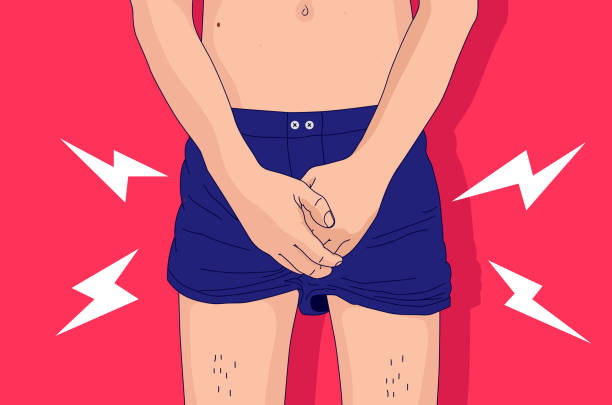Back
Male Pelvic Pain
By Shannon Strauch, PTA, STMT-1 on 5/23/2024

Pelvic pain in men can stem from various causes, and understanding these reasons is crucial for effective treatment. Here's a look at common causes of pelvic pain in men and how pelvic floor therapy can help:

Common Causes of Pelvic Pain in Men
Chronic Prostatitis/Chronic Pelvic Pain Syndrome (CP/CPPS):
Inflammation or irritation of the prostate and surrounding areas can lead to chronic pelvic pain. Symptoms include pain in the perineum, lower abdomen, and genital area, often accompanied by urinary symptoms and sexual dysfunction.
Pelvic Floor Dysfunction:
Muscle tightness, spasms, or weakness in the pelvic floor muscles can cause pain. Pain may be localized or radiate to the lower back, hips, and thighs.
Interstitial Cystitis (IC):
A chronic condition causing bladder pressure and pain, along with pelvic pain. Symptoms include frequent urination and discomfort in the pelvic region.
Hernias:
Inguinal or other types of hernias can cause pelvic pain, especially during physical activity or straining. Pain may be accompanied by a noticeable bulge in the groin area.
Infections:
Urinary tract infections (UTIs), sexually transmitted infections (STIs), or other infections in the pelvic region can lead to pain. Symptoms often include fever, urinary issues, and genital discomfort.
Nerve Entrapment:
Nerves in the pelvic region, such as the pudendal nerve, can become compressed or irritated, causing pain. This can result in sharp, shooting pain in the pelvic area.
Musculoskeletal Issues:
Conditions like muscle strains, joint dysfunction, or referred pain from the lower back can contribute to pelvic pain. Pain may worsen with specific movements or positions.
Testicular Pain or Conditions:
Conditions such as epididymitis (inflammation of the epididymis), orchitis (inflammation of the testicles), and testicular torsion can cause significant pelvic pain. Symptoms often include swelling, tenderness, and discomfort in the testicles and surrounding area.
Colon and Rectal Issues:
Conditions like irritable bowel syndrome (IBS), inflammatory bowel disease (IBD), and chronic constipation can lead to pelvic pain. Pain may be associated with bowel movements, and patients may experience bloating, diarrhea, or constipation.
Urological Conditions
: Bladder stones, urethral strictures, and benign prostatic hyperplasia (BPH) can cause pelvic pain and urinary symptoms. Symptoms may include difficulty urinating, frequent urination, and pain in the lower abdomen or perineum.
Post-Surgical Pain
Pelvic pain can occur after surgeries in the pelvic or abdominal area, such as hernia repairs, prostate surgery, or colon surgery. Pain may be due to scar tissue formation, nerve damage, or muscle imbalances.
Cancer
Prostate, bladder, colorectal, or testicular cancer can cause pelvic pain. Symptoms may include unexplained weight loss, changes in bowel or bladder habits, and persistent pain in the pelvic region.
Sexual Dysfunction
Conditions such as Peyronie's disease (development of fibrous scar tissue inside the penis) and erectile dysfunction can be associated with pelvic pain. Pain may occur during or after sexual activity.
Hip Joint Issues
Hip osteoarthritis, labral tears, and other hip joint problems can refer pain to the pelvic region. Pain may be aggravated by movement and physical activity.
Psychological Factors
Chronic stress, anxiety, and depression can contribute to or exacerbate pelvic pain. Pain may be linked to muscle tension and heightened pain perception.How Pelvic Floor Therapy Can Help Male Pelvic Pain
Pelvic floor therapy continues to be an effective approach to managing pelvic pain in men by addressing these diverse causes through comprehensive treatment strategies:
Manual Therapy:
Manual therapy techniques can also address adhesions from previous surgeries, scar tissue, and nerve entrapments. This approach helps improve blood flow, reduce inflammation, and enhance tissue healing.Biofeedback and Neuromuscular Re-education:
Advanced biofeedback techniques can help retrain the pelvic floor muscles to function properly, addressing both overactive and underactive muscles. This aids in restoring normal muscle tone and coordination.Pelvic Floor Exercises:
Exercise programs can be customized to address specific conditions like post-surgical pain, prostate issues, or hip joint problems. These exercises help restore balance and strength in the pelvic and surrounding muscles.Behavioral Modifications:
Education on bladder and bowel habits, dietary changes, and fluid intake can help manage conditions like IC, IBS, and chronic constipation. Learning proper techniques for activities like lifting and sitting can reduce strain on the pelvic floor.Pain Management Techniques:
Incorporating techniques like TENS (transcutaneous electrical nerve stimulation) and acupuncture can provide additional pain relief. These methods help manage chronic pain conditions and improve overall comfort.Education and Support:
Providing information about pain pathways, the role of the nervous system in chronic pain, and coping strategies helps empower patients. Support groups and counseling services can offer additional emotional support and resources. By addressing the multifaceted nature of pelvic pain in men, pelvic floor therapy offers a holistic approach to treatment, improving both physical and emotional well-being. Reach out to us at Pelvic Health Center in Madison, NJ to set up an evaluation and treatment! Feel free to call us at 908-443-9880 or email us at receptionmadison@pelvichealthnj.com.Read More:
How Chronic Pelvic Congestion in Men Contributes to Prostatitis By Shannon Strauch, PTA, STMT-1 on 12/11/2024 How lymphatic issues can cause symptoms of prostatitis Prostatitis and Tight Pelvic Floor Muscles: A Comprehensive Guide By Shannon Strauch, PTA, STMT-1 on 12/10/2024 How a tight pelvic floor can be the reason for prostatitis symptoms
Are you ready to live pain free?
Request An Appointment